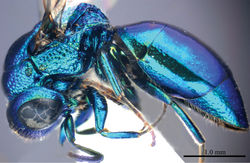Omalus probiaccinctus
| Notice: | This page is derived from the original publication listed below, whose author(s) should always be credited. Further contributors may edit and improve the content of this page and, consequently, need to be credited as well (see page history). Any assessment of factual correctness requires a careful review of the original article as well as of subsequent contributions.
If you are uncertain whether your planned contribution is correct or not, we suggest that you use the associated discussion page instead of editing the page directly. This page should be cited as follows (rationale):
Citation formats to copy and paste
BibTeX: @article{Wei2014ZooKeys407, RIS/ Endnote: TY - JOUR Wikipedia/ Citizendium: <ref name="Wei2014ZooKeys407">{{Citation See also the citation download page at the journal. |
Genus: Omalus
Name
Omalus probiaccinctus Wei, Rosa, Liu & Xu, 2014 sp. n. – Wikispecies link – ZooBank link – Pensoft Profile
Material examined
Holotype: ♀ (SCAU), Guizhou, Suiyang, Kuankuoshui National Nature Reserve (27°55'24"N, 107°11'8"E), 4.VI.2010, Jie Zeng, No. SCAU-O0039. Paratype: 1 ♀ (SCAU), Guizhou, Suiyang, Kuankuoshui National Nature Reserve, 4.VI.2010, Jie Zeng, No. SCAU-O0040.
Diagnosis
Omalus probiaccinctus sp. n. is related to Omalus biaccinctus based on the similar and peculiar punctures on the mesoscutum, which is unique in the West Palaearctic species. However, Omalus probiaccinctus sp. n. can be separated from the latter by having the body mostly metallic greenish-blue (body dark metallic blue or green, black medially on mesoscutum, metanotum, propodeum and metasoma in Omalus biaccinctus); tarsal claw with four teeth (three in Omalus biaccinctus); apex of T-III with faint median notch (apex of T-III with distinct, deep median notch in Omalus biaccinctus).
Description
Female (n = 2). Body length 4.8–5.7 mm (Plate 11). Fore wing length 4.1–4.4 mm. MS = 1.1 MOD. Head. Face with large round, dense (0–0.5 PD), and shallow punctures (Plate 12A). Scapal basin deep, glabrous, with weak and transverse striae (Plate 12A). Ocellar triangle isosceles. Postocellar line absent (Plate 12B). Gena with fine, oblique wrinkles. Mesosoma. Pronotum with fine, scattered (> 2 PD) punctures medially; with small, deep pits on anterior margin; with large and dense (0–0.5 PD) punctures laterally (Plate 12B). Mesoscutum transversally rugulose, with fine, sparse punctures evenly scattered (Plate 12D); notauli distinct, deep, complete; notaulic pit elongate; parapsidal lines distinct, shallower than notauli (Plate 12D). Scutellum without flattened fovea on anterior margin; with broad, almost impunctate median area extend along its length, slightly convergent posteriorly (Plate 12D); posterior margin of scutellum with numerous fine, short, longitudinal striae; with large, round, dense (0–0.5 PD) punctures laterally, becoming larger, deeper towards alar foveae (Plate 12D). Mesopleuron with very weak striae between punctures (Plate 12C). Metanotum evenly round, with large, deep, areolate-reticulate punctures (Plate 12D). Propodeum with lateral margin concave before propodeal angle; propodeal angle distinct, pointing posterolaterally (Plate 12D). Tarsal claw with four teeth.
Metasoma. Distinctly elongate, L/W = 2/1, with T-III slightly constrict laterally towards the apex (Plate 12E). T-I and T-II almost impunctate dorsally, with fine, scattered punctures laterally. T-III with slightly denser punctures than those on T-II (Plate 12E); apex of T-III with narrow (1/5 MOD), brownish rim, with faint median notch (Plate 12F).
Colouration. Head and mesosoma metallic greenish-blue, with purple reflections. Antenna black, with scape and pedicel metallic green. Tegula metallic greenish-blue, with apex brown. Leg metallic greenish-blue, with tarsus brown. Metasoma metallic greenish-blue, with purple reflections.
Male. Unknown.
Distribution
China (Guizhou).
Biology
Unknown. Collected in June.
Etymology
The name probiaccinctus is derived from the Latin preposition pro- and the chrysidid name biaccinctus.
Original Description
- Wei, N; Rosa, P; Liu, J; Xu, Z; 2014: The genus Omalus Panzer, 1801 (Hymenoptera, Chrysididae) from China, with descriptions of four new species ZooKeys, 407: 29-54. doi
Images
|

